e-Commerce Solution Covering Business Customer Ordering and Information Processes at Xiameter
Dow Corning, world market leader in the manufacture of silicone products, offers commodity products under the brand Xiameter.com for 15% less than the usual market prices. Xiameter.com customers do without the comprehensive service for which Dow Corning stands and follow the business rules which include ordering through the website. This customer segmentation means that Xiameter.com can serve commodity customers through lean, standardized processes with low-price offers. Customers who inquire about additional services (such as e.g. Vendor Managed Inventory (VMI)) or individually tailored products and services are still served by the brand Dow Corning.
1. Company and Problem
Company. Xiameter (www.xiameter.com) is a web-enabled business model that offers low-base price for silicone products through transparent and unprecedented pricing and transaction simplicity. Xiameter operates as an separate business unit and brand within Dow Corning. Dow Corning (www.dowcorning.com) was established in 1943 specifically to explore the potential of silicones. It was created as a 50-50 joint venture between Corning Glass Works (now Corning, Incorporated) and The Dow Chemical Company. Today Dow Corning provides over 7,000 silicone based products and services worldwide. Dow Corning has sales offices, manufacturing sites (22 locations) as well as science and technology laboratories around the globe, and enjoys a 35% market share of silicone products.
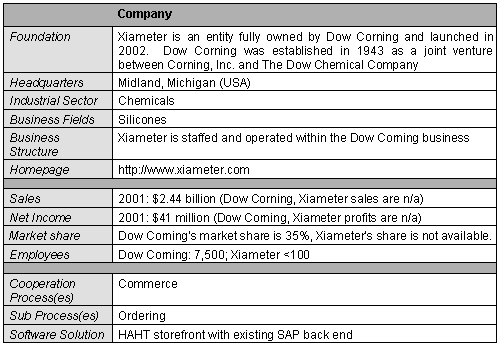
Table 1-1: Brief profile of Dow Corning’s Xiameter
Problem. Dow Corning is the pioneer in developping silicones, starting in 1943. The industry has seen a compounded annual growth of 15% through the 1990s. Silicones currently represent a $7 billion global market with Dow Corning having a market share of 35% [see Rozin/Magnusson 2002, p. 186f]. Despite being only 60 years old, the silicone industry—like the entire sector of specialty chemicals—is maturing, and is now struggling with the increasingly rapid commoditization of products and the intensifying pressure on prices, margins and costs—Xiameter estimates that 30-40% of silicones are now considered commodity products. While specialty chemical companies are beginning to get serious about tackling product commoditization, Dow Corning’s challenge was to be able to compete in the commodity silicone business and to make silicone performance a true option at the right price for a broader cross-section of customers, including those who currently don’t use silicones (e.g. organic chemical users). This is balanced by the desire to maintain its image of an “innovative company” that is committed to being the leader in silicone-related chemistry by introducing new products to the specialty chemical’s business.
2. Starting Point - Dow Corning Business Model
Strategy. Despite being in a partially commodity business, the Dow Corning brand projects the best in class service and innovation in the silicone business. These services include: development of customized products, technical product’s support, express delivery, local inventory (VMI), strategic collaboration with customers on silicone’s uses and technology, and working at customer site.
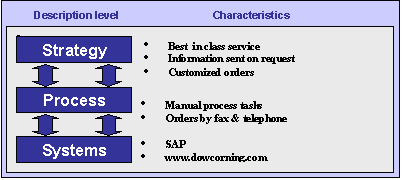
Figure 2-1: Main Features of Dow Corning’s Sales Business
Process. Dow Corning’s customers currently order via phone/fax/EDI, with the majority of orders placed via telephone. Most of the orders (90%) are custom orders, e.g. express delivery, special delivery, odd lot quantities, technical service requirements, etc. Usually it takes five phone calls to place such an order and to coordinate it. However, this business model and process allows Dow Corning to offer it’s customers the best in class technical (e.g. helping customers use Dow Corning products) and customer service. Due to the rapidly changing market conditions as well as storage issues, silicones are no more manufactured to stock (i.e. manufactured when order is received, rather than delivered from stock).
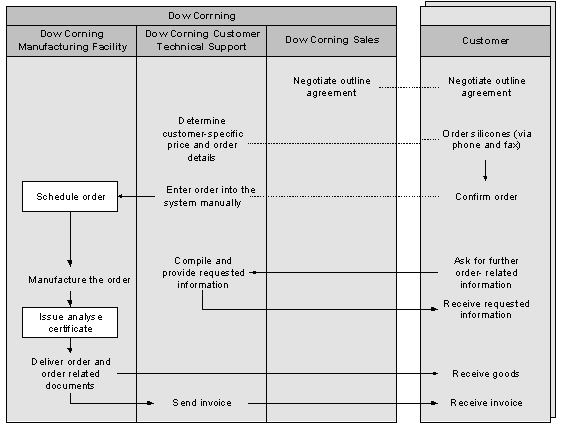
Figure 2-2: Sales Process at Dow Corning
Systems. Dow Corning uses SAP as its ERP system. The Dow Corning web site serves primarily for providing technical information (Material Safety Data Sheets, generic certificates of analysis, product usages, etc.) to customers and has limited ordering capabilities. According to the customer’s qualification (credit worthiness) and to responsible use considerations, customers can re-order from a limited product selection on the Dow Corning web site, if they have ordered and used these products previously.
Problem Perception. Dow Corning’s customers have varying sets of needs. Some customers were are interested in working with Dow Corning to innovate new products (new products customers). Another set of customers wants Dow Corning to work with them to improve the usage of Dow Corning products in their processes (technical buyer). Still, another set of customers asks Dow Corning to help them drive down the costs of their total production process (technical economic buyer). Finally, Dow Corning has a set of customers using large amounts of material by saying “We know how to use the products. We want three simple things. We want high quality, reliability, and low price. We do not need the great technical service which Dow Corning is known for” (economic buyer). In order to address this increasing commoditization of parts of the silicone business without loosing its reputation for great technical service and innovation, Dow Corning could not afford to ignore the increasing commoditization of silicones.
3. Project
Goals. In January 2001, Dow Corning’s Chairman & CEO Gary Anderson asked Donald Sheets (now General Manager of Xiameter) to determine how Dow Corning could pursue the commodity silicone business, while protecting Dow Corning’s brand image as a high quality, high service, value added silicone supplier. Sheets, along with K. Michael Lanham (now Global Commercial Director for Xiameter, with responsibility for global marketing and sales, Internet commercial operations, and brand positioning) used the Internet to create a low cost/low price business model that is streamlined and driven by strict business rules. These business rules of Xiameter were aimed at providing clarity and achieving overall low costs for their products. They outline a clear and concise way of doing business that allows Xiameter to operate in the most efficient way that is possible. Conformance to these business rules set by Xiameter would be a requirement for customers to order from Xiameter. Project timeline from conception to roll out was to be one year (i.e. online and receiving orders by January 2002).
Execution. The project was carried out in two phases, each lasting six months. The first phase involved Don Sheets and Mike Lanham, with support from Dow Corning, in developing Xiameter’s business strategy. In June 2001, Sheets and Lanhan got approval from Dow Corning’s Executive committee to launch this new industry. Their goal was by January 7, 2002, to create a new brand with a product line that currently contains 350 products, to build a new website with an an online order entry system, and to hire a team of experts to run this business. Meanwhile these six months, while prepared to go outside of Dow Corning, Xiameter was staffed from Dow Corning personnel with the help of an outside consultant to identify needs and candidates. Xiameter’s core team consists of less than 100 people, but the team at large includes several hundreds of Dow Corning’s employees, including IT staff. Additionally, the commodity silicone business was taken out of existing Dow Corning business units and assigned to Xiameter.
On January 7, 2002, Xiameter.com was launched as a beta site to selected customers. On March 5, 2002, Xiameter.com was launched to the world via media announcements in New York, London, Brussels, Hong Kong, Seoul, Shanghai, and Beijing. Xiameter’s customer list is expanding since then, and Xiameter is selling products into 23 countries with the ability to sell into 55 countries.
Critical Success Factors. For Don Sheets and Mike Lanham, the key to Xiameter’s success was change management during the implementation. Xiameter fundamentally changed the way how Dow Corning segments its customers and even moved a large amount of values to a new business unit. This would not have been possible without the CEO’s commitment to the project, and the understanding of the difficulty for traditional organizations to change their business processes. During the design phase (first six months of the project), Xiameter was on a “need to know basis” in order to keep the process moving forward and to minimize the impact of opponents within Dow Corning at this early stage of the project. Additionally, spending enough time in the design phase (6 months), committing to a hard time line (prototype in six months, i.e. Jan. 2002) and extensive testing were also cited as key success factors.
4. New Solution
Strategy. Xiameter is a web-enabled business model and global brand (separate from the Dow Corning’s one) that offers the lowest-base price for silicone products through transparent and streamlined pricing and transaction simplicity. For those customers willing to follow defined business rules (order quantities, web site ordering, no service, set lead times, etc.), Xiameter offers significant cost savings (~15% compared to Dow Corning prices). Don Sheets feels that the Xiameter business model represents a “fair deal”, no service in exchange for lower prices; and business rules that penalize both the customer and Xiameter when being violated.

Figure 4-1: Main Features of the Sales Processes within Xiameter and Dow Corning
Process. Processes are defined by business rules set up by Xiameter (cf. Table 4-1). These rules pertain to ordering, pricing, shipment, communication and payment.
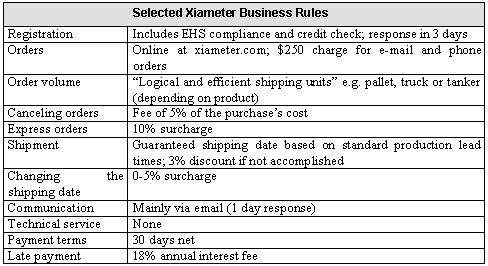
Table 4-1: Selected Xiameter Business Rules
[cf. www.xiameter.com](reffering to [Xiameter 2003], [Roberts/Hunter 2002])
- Ordering is primarily through the Xiameter.com website only, which is only available in English to keep down maintenance costs. Customers have approached Xiameter about building versions in their native language, which Xiameter has refused unless the customer is willing to bear the costs of maintenance. Currently less than 10% (and decreasing) of Xiameter’s customers order via phone/fax/email where they have to pay a $250/order surcharge. Phone/fax/email orders are manually entered into Xiameter’s ordering interface by Xiameter’s personnel. Depending on the product, orders can only be placed in “logical and efficient shipping units”, e.g. pallet, truck or tanker.
- Once the order is placed by the customer, three automated emails are generated and sent to the customer: order acknowledgement (within 15 minutes of order receipt), shipping notice (when the material has left the plant; the shipping date is guaranteed or Xiameter pays 3% discount on next order), and the invoice (with link to MSDS, certificates of analysis, etc). C
- Customers see prices for their country which are good for orders shipped in 7-90 days. Express orders (i.e. ship in less than 7 days) require an availability check and incur a 10% surcharge, since most products are made to order. While dynamic pricing (i.e. based on market conditions and manufacturing capacity) is available, most customers prefer prices that are based on negotiated agreements for a certain time period, because prices fixed like that allow a better production and sales planning. There is a $50,000/year minimum order quantity to prevent price shopping.
- Xiameter sells products manufactured by Dow Corning who maintains manufacturing facilities worldwide – Xiameter’s products are sourced from one manufacturing facility per geographic area. Shipping date lead time is based on complete replenishment (i.e. lead time is total manufacturing plant time). The plant’s capacity plays some role in product pricing, but it is not the main driver. Shipments are made directly from the plants to the customer to avoid warehousing costs. The 3% late shipment credit is charged to the sourcing plant’s cost center. This helps Xiameter to observe its own business.
- Xiameter uses Dow Corning’s third party logistic provider, UTI, to handle the product shipments. While Xiameter guarantees the shipping date (date on which product leaves manufacturing plant) it does not guarantee the delivery date (arrival at customer’s site).
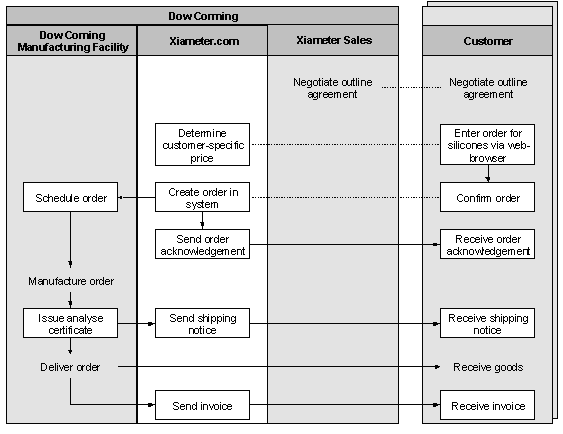
Figure 4-2: Sales Process at Xiameter
Xiameter’s customers range from small entrepreneurs to multi-national corporations. Xiameter has found out that customers will adapt their thinking and processes to meet Xiameter’s business rules in order to take advantage of lower prices. Customers who want to order from Xiameter and still want to receive technical service can obtain a service contract from Dow Corning. Despite its web based and streamlined operations, Xiameter states that customer relationship management is still important. As such, local Xiameter’s personnel negotiate about prices with customers and advise (market research, pricing research, etc.) on the local spot market.
Systems. Xiameter uses Dow Corning’s extensive SAP R/3 backbone and HAHT’s Demand Chain Management Software (www.haht.com), allowing effective order processing and customer interaction. Although Xiameter considered using SAP’s customer interface, it was felt that while its “drag & relate” functionality was interesting, the overall interface was poor. Xiameter evaluated several storefront packages, and HAHT was chosen as the quickest and easiest to implement, as well as being the only company that could meet Xiameter’s time frame of a six month implementation. HAHT is now used in Dow Corning’s account management group and standard for future customer interfaces.
Cost/Benefit. Dow Corning’s launch of Xiameter was driven primarily by the increasing commoditization of silicones and had a very specific strategy, targeting experienced, price sensitive, commodity buyers. This leaves customers the choice between the Dow Corning and the Xiameter brand. Some customers have chosen the Xiameter brand, others have stayed with the Dow Corning brand, while still others choose to purchase from both (getting technical service with the Dow Corning products). Launched in January 2002, Xiameter has seen rapid adoption from both existing Dow Corning customers as well as new customers, with success in all major geographies. They are particularly pleased with their success in Asia. Large average order sizes, streamlined processes, and limited customer contact has allowed Xiameter to keep prices and costs down. Xiameter believes that by offering silicones at a significant cost saving level, it can grow the overall silicone market by giving the $100 billion performance enhancing materials market an alternative to organic chemicals? Currently, there is no direct competitor to Xiameter. According to Lanham, marketplaces (e.g. Elemica, which offers a full set of supply chain services (planning, forecasting, optimization, vendor managed inventory and order mangement); Chemplorer, which offers a combination of access (technology), catalogs (content), negotiations, and services) try to offer low prices and a lot of technical service. Xiameter can’t imagine how that combination will work, since it will be difficult for sellers to realize value when having to provide low prices and technical service.
While Dow Corning’s order process remains the same, Xiameter has “forced” Dow Corning to use SAP business process flows, i.e. no work arounds, etc. For example, a “goods issue” document is printed when the truck (with product) is ready for delivery. A “goods issue transaction” is entered into SAP, thereby informing the ERP system that delivery has been made (i.e. product has left Dow Corning manufacturing facility and is in the hands of the shipper). “Goods issue” transactions are supposed to be keyed into SAP on the day of shipping. However, Xiameter found that operators often did not key “goods issue” on the same day, resulting in an automated (via email) late shipment notice sent to the customer, which resulted in a late shipment charge.
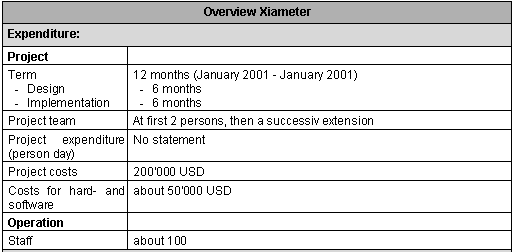
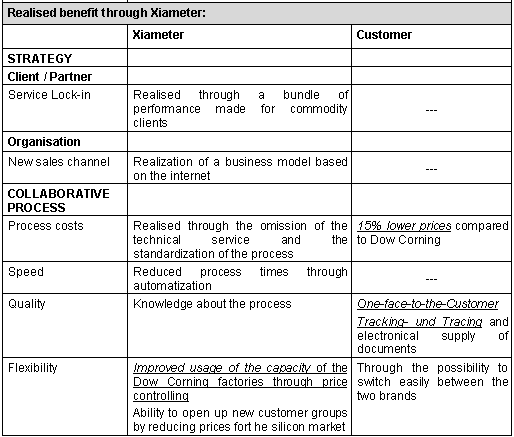
Figure 4-2: Xiameter - Expenditure and Benefits Achieved
Further development. Xiameter is currently thinking of offering its business model and brand name to other specialty companies. Xiameter would provide its partners with the Xiameter storefront, but send orders via XML or EDI (no direct ERP connection) to partners for processing and fulfillment. Xiameter feels that it can offer partners a recognized brand and storefront, and a clean data stream, while allowing them to “outsource” their commodity products and protecting their brand image.
5. Learnings
Dow Corning’s launch of Xiameter, an online channel for selling commodity silicones at guaranteed low prices, is one of the clearest signs to date that specialty chemical companies can address product commoditization. According to Lanham and Sheets, the key to Xiameter’s success was to understand that cost savings for Dow Corning were not in connectivity, but in the automation of the customer interface, the establishment of business rules and the willingness to stick with them.
Three important points from the Xiameter case are:
- No changing from the old, profitable business model to a new business model. Dow Corning successfully identified and segmented the needs of its customers, and continues to offer business models to satisfy all segments.
- The importance of a new brand name, so as not to affect the brand image of Dow Corning.
- Customers who are willing to change their processes and thinking in order to meet Xiameter’s business rules in return for significant cost savings. Customized collaborative processes do not have to be highly customized to be successful.
Â
Literature
[Roberts/Hunter 2002]
Roberts, M., Hunter, D., Dow Corning's Xiameter Tackles Commoditization, e-chemmerce, http://www.e-chemmerce.com/aboutus/samples/0302es3.html, 2003-10-07
[Rozin/Magnusson 2003]
Rozin, R.S., Magnusson, L., Processes and Methodologies for Creating a Global Business-to-Business Brand, in: The Journal of Brand Management, February 2003, vol. 10, no.3, pp.185-207
[Xiameter 2003]
Xiameter, Learn the Rules, Dow Corning Corporation, http://www.xiameter.com/content/bxrules/learn_the_rules.asp, 2003-10-07



